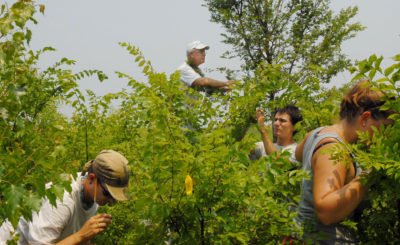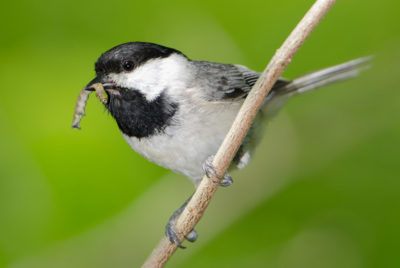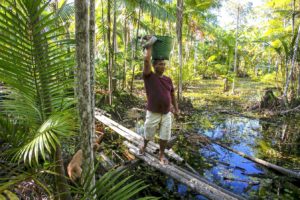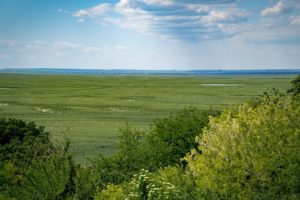For years, Doug Tallamy sounded the alarm about the grave threat that plants introduced from abroad pose to native insects. By transforming native plant communities into so-called novel landscapes increasingly dominated by exotic species on which many insects cannot feed, the University of Delaware entomologist speculated, they imperil not only insects but also the birds and other animals that depend on insects for survival.
Not everyone has greeted the thesis with open arms. The effect of introduced plants on native biodiversity has been one of the most contentious issues in ecology, compared to gun control, abortion, and other “hot-button issues in contemporary American culture” by Peter Del Tredici, senior research scientist at Harvard’s Arnold Arboretum. “Over the past few decades,” 19 leading ecologists, including Del Tredici, wrote in a 2011 commentary in the journal Nature, “‘non-native’ species have been vilified for driving beloved ‘native’ species to extinction and generally polluting ‘natural’ environments… ‘Nativeness’ is not a sign of evolutionary fitness or of a species having positive effects.”
Dozens of recent studies, however, have provided evidence that supports Tallamy’s hotly disputed hypothesis. In a paper published online on November 18 in the journal Ecological Entomology, Tallamy and two co-authors review the research buttressing the proposition that the widespread displacement of native plant communities by non-native plants in agriculture, agroforestry, and horticulture is a key cause of insect declines.
Insects have been clobbered by an array of threats, from habitat destruction and deforestation to climate change.
The issue of non-native plants has become newly urgent as the scope of the “insect apocalypse” has become clear. In the past few years, insect declines have been documented around the globe, including western and northern Europe, North America, neotropical countries such as Costa Rica and Puerto Rico, and even the High Arctic. In a comprehensive review of 73 historical reports published in Biological Conservation, scientists found that in terrestrial ecosystems, Lepidoptera (butterflies and moths), Hymenoptera (bees and their close relatives), and Coleoptera (beetles), as well as four major aquatic insect groups such as Odonata (dragonflies and damselflies), have suffered dramatic declines. What’s more, it’s not just specialist species with restricted ecological requirements, like dependence on a small number of plants, that have slumped but many common and generalist species as well. A blockbuster 2017 study that revealed a shocking 76 percent decline in the biomass of flying insects over 27 years at protected areas in Germany catapulted the plight of insects into the public consciousness.
According to researchers, the global insect demise began at the dawn of the 20th century, accelerated during the 1950s and 1960s, and reached alarming proportions globally during the past two decades. Reports of an ongoing “bird armageddon” that mirrors the insect apocalypse suggest that insectivorous birds have been collateral damage in the collapse of insect populations worldwide.
Scientists say that insects have been clobbered by an array of continuing threats, from habitat destruction, deforestation, climate change, and light pollution to the rise of industrial agriculture. A widely publicized study published last year in PLOS ONE calculates that U.S. agriculture is 48 times more toxic to insects than it was 25 years ago, with neonicotinoid pesticides accounting for 92 percent of the lethal escalation; the study notes that “this increase in toxicity loading is consistent with the reduction in beneficial insect and insectivorous bird populations observed in recent years.” Yet one threat that has attracted little notice, and that more than two dozen international experts failed to mention in their recommendations for solutions to the insect crisis, is the replacement of native plants with non-native vegetation under way around the world.
Zebra swallowtails are entirely dependent on pawpaw trees, which have leaves that are the butterflies' larvae only source of food. Courtesy of Douglas Tallamy
Tallamy’s paper aims to rectify the oversight. University of Connecticut entomologist David Wagner, who peer-reviewed the paper, called it a “much needed contribution” to the insect conservation literature. He added that it “does an especially laudable job of exposing the weak footing of many arguments that some have used to claim that non-native plants are not a threat to biodiversity, which I regard as nonsense.”
Mark Davis, an ecologist at Macalester College, has a different view. He points out that even Tallamy and his co-authors concede that they can only extrapolate the impact of non-native plants on insect populations from short-term studies performed at local scales because longer-term, landscape-scale studies have not yet been done. “In other words,” says Davis, “there is as yet no evidence that non-native plants reduce insect abundance over the general landscape.”
Tallamy’s early hunch that non-native plants have helped decimate insect populations was based on decades of research showing that many insects, especially the phytophagous or plant-eating species that account for most insect diversity, depend on a limited number of plants for survival. Since the 1960s, scientists have attributed this so-called host plant specialization to several factors, including the need for feeding insects to develop ways to get around plant defenses, like the production of chemical compounds that would be fatal to other species. As a result, the diet of most insects is restricted to a single plant family, and the closer species are to the tropics, the more constrained their menus are likely to be. More than 90 percent of the insect herbivores in the rainforests of Papua New Guinea, for example, can utilize only plants in a single genus, or a closely related group of species.
The diet restrictions of butterflies and moths have been studied more than those of other insect groups whose populations are plummeting. Five years ago when scientists looked at the diet breadth of plant-eating insects around the world, they found that 69 percent of caterpillar species can develop on just one plant family. Given such restricted diets, Tallamy and his co-authors write, it stands to reason that “the displacement of native plants by non-native species may have profound effects on phytophagous insect populations everywhere.”
When native host plants dwindle or disappear, the populations of plant-eating insects shrink and become less diverse.
In fact, research has shown repeatedly that when native host plants dwindle or disappear from an area, the populations of insect herbivores shrink and become less diverse. An analysis of 76 studies of caterpillar health on native and introduced plants found that with few exceptions caterpillars were larger and more likely to survive when reared on their native host plants. And in plant communities invaded by non-native species, the study found, the abundance and diversity of butterflies and moths were significantly reduced.
There have, however, been exceptions. In a small percentage of cases, insect herbivores have adopted introduced plants as food sources, especially if they belong to the same genus or family as their native hosts. In the most celebrated example, 34 percent of California butterfly species were found to feed or lay their eggs on non-native plants.
Because not every study has demonstrated negative effects, the long-running controversy over whether introduced plants are harmful to native insects continues. Ecologist Richard Hobbs, a senior research fellow at the University of Western Australia’s School of Biological Sciences, says that “the assumption that species cannot adapt to new resources is being increasingly questioned.” He notes that “studies indicate that non-native species can have positive, neutral, or negative impacts, and it is not as simple as just assuming that non-native species are just plain bad.”
University of Delaware entomologist Douglas Tallamy (top) and students compare insect use on Chinese and American elm trees. Courtesy of Douglas Tallamy
According to Tallamy, however, the positive cases are uncommon, and “you have to look at the negative as well as the positive effects.” He points to kudzu, a rampant invader of the eastern U.S. that has been found to support the silver-spotted skipper, a native butterfly. This has led some people to conclude that invasive non-native plants are not all bad. “With a kudzu invasion you may gain the silver-spotted skipper,” Tallamy responds, “but you lose literally thousands of species” that depend on the native plants the kudzu replaced.
Even among those who consider non-native plants a significant problem, there is some difference of opinion about the degree of threat that they pose. University of Connecticut’s Wagner, who has described the plight of insects as “death by a thousand cuts,” says “there’s no question that invasive species and the ornamentals we plant in our yards are taking a toll on insects.” Although they’re “super important stressors,” in Wagner’s words, the truly destructive “cuts” are agricultural intensification, deforestation, and land use change. “Those are ones that are just wicked bad,” he adds, “and are making it tough for species to continue to live with humans on this planet.”
Tallamy says that in 2001, when he began to focus on this subject, “there was a whole lot in the literature on the problems caused by invasive species but wrecking the food web wasn’t one of them.” When he realized how large an area has been transformed by non-native plants, it struck him that this was a major issue. Nearly half of the planet’s land is now in some form of agriculture. According to the World Bank, almost 45 percent of the land in the lower 48 U.S. states is devoted to production agriculture, and this figure soars when the area occupied by rangeland and tree farms is factored in. According to the UN Food and Agriculture Organization, 44 percent of the world’s planted forests include non-native tree species; many have escaped from cultivation and now dominate nearby native forests. Tallamy and his co-authors also call attention to the fact that due in large part to the strong preference for exotic plants in landscaping, urban areas are rife with introduced species, and it’s estimated that these quickly growing areas could cover as much as 20 percent of the earth’s habitable land by 2030.
Some 96 percent of North American terrestrial birds rear their young on insects, so when insects decline, they do too.
Horticulture has been one of the primary proliferators of invasive non-native plants in natural and human-dominated landscapes alike. Studies show that 50 to 70 percent of invasive and naturalized species arrived in their new lands via the horticulture trade. And Tallamy points out that even if these ornamental plants never become invasive, they are still replacing the native vegetation that is critical for the survival of most insects.
In the words of a groundbreaking 2018 Proceedings of the National Academy of Sciences paper co-authored by Tallamy, “the widespread preference for non-native plants in the horticultural industry has globally transformed millions of acres from potential habitat into ‘food deserts’ for native insects, with the unintentional consequence of reducing the abundance and distribution of birds as well.” The paper was the first to provide data demonstrating that the decline of insects has cascading effects higher up the food chain.
For three years, lead author Desirée Narango, a postdoctoral fellow at the University of Massachusetts, Amherst, and a team of field assistants measured what happens to breeding Carolina chickadees and the caterpillars that are essential food for their chicks in the suburbs of Washington, D.C. Among their findings is that parent birds foraged for food on native plants 86 percent of the time. Yards dominated by introduced plants produced 75 percent less caterpillar biomass than primarily native landscapes and were 60 percent less likely to have breeding chickadees at all. Nests that chickadees did build in yards with many non-native plants contained 1.5 fewer eggs than nests on properties dominated by natives.
A Carolina chickadee carries an insect from a native tulip tree to its nestlings. Scientists found that chickadees nests in suburban yards dominated by non-native plants contain 1.5 fewer eggs than those in yards with numerous natives. Courtesy of Douglas Tallamy
The chickadees were able to achieve the so-called replacement rate — that is, produce enough chicks each year to replace adults that succumb to old age and predators — only in yards with less than 30 percent introduced plant biomass; unfortunately for the birds, Narango and her co-authors found that, on average, 56 percent of the plants in the Washington, D.C. suburbs are not native. They point out that if a common “urban-adapted” bird like the Carolina chickadee is limited by the relative lack of food in a typical suburban landscape, it may be an even bigger problem for birds with more specialized diets. What’s more, some 96 percent of North America’s terrestrial birds rear their young on insects rather than seeds or berries, so when insects decline, they do too.
For these reasons, Tallamy has proposed a domestic version of Harvard biologist E.O. Wilson’s Half Earth Project. If American homeowners converted half of their lawn to productive native plant communities, he says, they would create a “Homegrown National Park” larger than the Everglades, Yellowstone, Yosemite, Grand Teton, Canyonlands, Mount Rainier, North Cascades, Badlands, Olympic, Sequoia, Grand Canyon, Denali, and Great Smoky Mountains National Parks combined.
At the conclusion of their new paper, Tallamy and his co-authors concede that critical gaps in our knowledge remain. But they conclude that at this point enough studies have been completed and enough evidence gathered that, in Tallamy’s words, “we can now definitively answer the question, ‘Are alien plants bad?’ In terms of supporting insects, the preponderance of the evidence says yes.”






